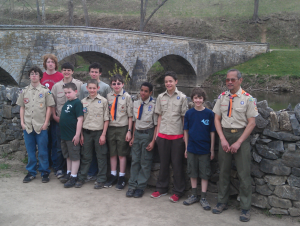To kick off their Spring Break members of Milton’s Boy Scout Troop 3 travelled 450 miles southwest to the rolling hills of south central Pennsylvania to tour two of the greatest battlefields of the American Civil War, Gettysburg, Pennsylvania and Antietam, Maryland. The Scouts and their leaders were met by their guide for the weekend, John Buchanan, brother and uncle to Troop 3 members Greg & David Buchanan. John Buchanan lives in Southside Virginia and is an avid student of the Civil War. He has led more than 25 Scout groups on these battlefields over the years.
The Scouts learned about life as a soldier in the Civil War, learning about the arms and equipment, how they were organized and how they fought and even got to sample actual hardtack and salt beef, staple of the soldiers’ diet. They also learned about the primitive practice of battlefield medicine which existed at the time. Most importantly they learned about the valor and sacrifice of the soldiers of both sides. At the completion of the discussion Troop 3 was reorganizes into Company A, 3rd Massachusetts Volunteer Infantry. Scout switched from their Troop leadership positions and assumed military rank for the weekend.
On a bright and brisk Sunday morning the Troop held a Scout Worship Service on McPherson’s Ridge, site of opening shots of the Battle of Gettysburg. For the remainder of the day the Troop visited the many iconic segments of the battlefield as they traced the myriad of actions which occurred over the three days of 1 – 3July 1863. The tour included McPherson’s Ridge, Little Round Top, Devils Den, the Wheatfield, the Slaughter Pen, Cemetery Hill and Ridge, all sites of desperate struggles over the three days 150 years ago. In the middle of the afternoon the Troop moved to Seminary Ridge and assumed the mantle of Company A, 3rd Virginia Infantry. In this guise they took part in a reenactment of the fabled Pickett’s Charge. The Scouts learned from letters and diaries of Confederate soldiers of the devastating effects of Union artillery fire on the 12,000 men as they crossed the mile of open ground. The charge culminated at the Bloody Angle section of the Union Line on Cemetery Ridge. There the Troop talked about the effect of the attack on Union forces and visited the monument of the 20th Massachusetts Volunteer Infantry, The Harvard Rifles. The units was composed of men from Milton, Hyde Park, Readville, Boston, Dorchester, Roslindale and Jamaica Plain sections of Boston. Most of the officers were Harvard University Alumni or students. The monument features a large boulder made of puddingstone. It was brought for the monument’s dedication from Roxbury, where many of the men of the regiment had played on such boulders as they grew up. The monument was dedicated on October 20th, 1885.
The Troop learned the story of a less well known Massachusetts unit, the 9th Massachusetts Battery. On 2 July 1863 this untested unit of artillery helped slow the Confederate advance through the Peach Orchard. In their first battle, the men fought with tenacity and courage. When ordered to retreat they chose to continue to operate their pieces, using the recoil of the cannons to “retreat by recoil”. Their sacrifice helped buy the time for the Union commander, Major General George G. Meade, to bring reinforcements in to stop the Confederate onslaught.
As a culmination the day’s events the Troop paid a visit to the Union Cemetery where Abraham Lincoln gave his Gettysburg address during the cemetery’s dedication on 19 November, 1863. To commemorate the 148th Anniversary of the assassination of President Lincoln the Troop recited the Gettysburg address.
On Monday 15 April the troop conducted a tour of the Battle of Antietam. While enroute to the battlefield in Sharpsburg, Maryland, they took Old Highway 40 the original National Road. They stopped at the summit of South Mountain, Maryland and discussed the impact of the delaying action fought there between the Army of the Potomac and Army of Northern Virginia on 14 September 1862. This delay allowed the Confederate commander General Robert E. Lee to concentrate his scattered forces along Antietam Creek outside of the hamlet of Sharpsburg, MD.
The Troop learned about the actions which began at sunrise on 17 September 1862. Beginning at the Cornfield, the Troop moved from the East Woods to the West Woods, the Mumma Farm and to the Bloody Lane. While there the Troop assumed the fighting positions the Confederates took on that morning to gain an appreciation of why Union forces had such a difficult time in assaulting the center of the Confederate line. They learned about another group of iconic Massachusetts soldiers, the 28th Massachusetts Volunteer Infantry, Irish immigrants who were members of the famed Irish Brigade. This unit was part of the Union Assault on 17 September which would finally break the Confederate center.
From the Bloody Lane the troop visited the most famous section of the battlefield, Burnsides Bridge over Antietam Creek at the Southern end of the battlefield. They learned of the eventual successful Union assault across the bridge and attack up the opposite heights. This Union assault was finally stopped by a Confederate counterattack with troops arriving from Harpers Ferry, West Virginia arriving in tome to stop the Union advance.
Upon completion of the tour the Troop returned to their campsite at Camp Tuckahoe, a Boy Scout Camp in Dillsburg, A, operated by the New Birth Of Freedom Council out of the Harrisburg, PA area. The troop returned to Milton on 16 April 2013. Troop 3 is chartered by Saint Mary of the Hills Catholic Church of Milton. Dan Zamora is the unit’s Scoutmaster.

